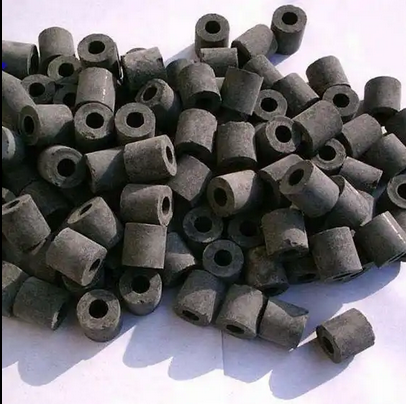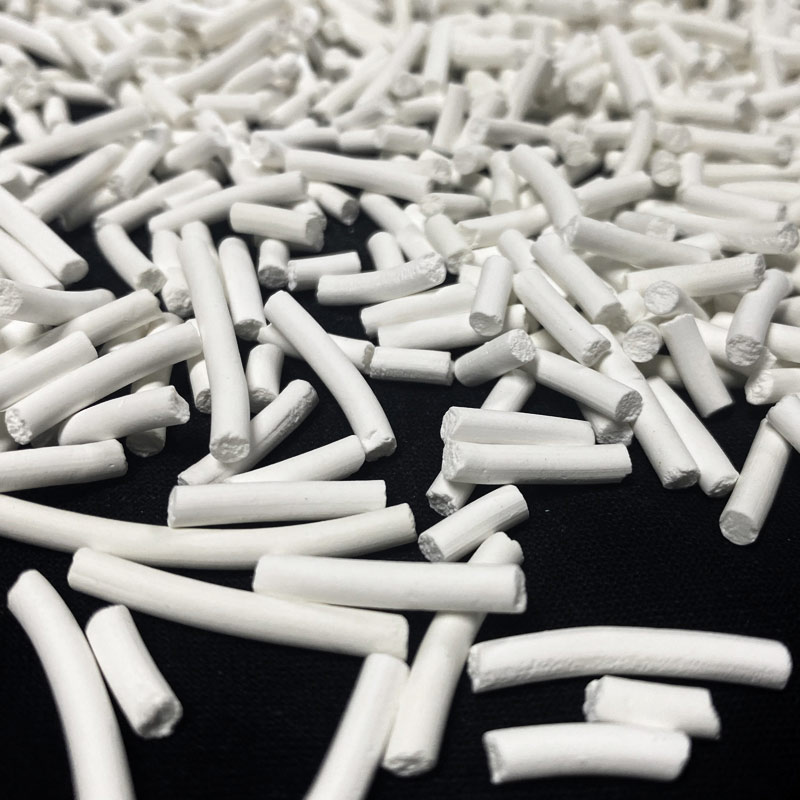Catalyst
-

Low temperature shift catalyst
Low temperature shift catalyst:
Application
CB-5and CB-10 are used for Conversion in synthesis and hydrogen production processes
Using coal,naphtha,natural gas and oil field gas as feedstocks,especially for axial-radial low temperature shift converters.
Characteristics
The catalyst has the advantages of activity at lower temperature.
The lower bulk density,higher Copper and Zinc surface and better michanical strength.
Physical and chemical properties
Type
CB-5
CB-5
CB-10
Appearance
Black cylindrical tablets
Diameter
5mm
5mm
5mm
Length
5mm
2.5mm
5mm
Bulk density
1.2-1.4kg/l
Radialcrushing strength
≥160N/cm
≥130 N/cm
≥160N/cm
CuO
40±2%
ZnO
43±2%
Operating conditions
Temperature
180-260°C
Pressure
≤5.0MPa
Space velocity
≤3000h-1
Steam Gas Ratio
≥0.35
Inlet H2Scontent
≤0.5ppmv
Inlet Cl-1 content
≤0.1ppmv
ZnO desulfurization Catalyst with high quality and competitive price
HL-306 is applicable to desulfurization of residue cracking gases or syngas and purification of feed gases for
organic synthesis processes. It is suitable for both higher (350–408°C) and lower(150–210°c) temperature use.
It can convert some simpler organic sulfur while absorbing inorganic sulfur in gas stream. Main reaction of the
desulfurization process is as follows:
(1) Reaction of zinc oxide with hydrogen sulfide H2S+ZnO=ZnS+H2O
(2) Reaction of zinc oxide with some simpler sulfur compounds in two possible ways.
2.Physical Properties
Appearance white or light-yellow extrudates Particle size , mm Φ4×4–15 Bulk density, kg/L 1.0-1.3 3.Quality Standard
crushing strength, N/cm ≥50 loss on attrition, % ≤6 Breakthrough sulfur capacity, wt% ≥28(350°C)≥15(220°C)≥10(200°C) 4. Normal Operation Condition
Feedstock : synthesis gas , oil field gas, natural gas, coal gas. It can treat gas stream with inorganic sulfur as high
as 23g/m3 with satisfactory purification degree. It can also purify gas stream with up to 20mg/m3 of such simpler
organic sulfur as COS to less than 0.1ppm.
5.Loading
Loading depth: Higher L/D (min3) is recommended. Configuration of two reactors in series can improve utilization
efficiency of the adsorbent.
Loading procedure:
(1)Clean the reactor before loading;
(2)Put two stainless grids with smaller mesh size than the adsorbent;
(3)Load a 100mm layer of Φ10—20mm refractory spheres upon the stainless grids;
(4)Screen the adsorbent to remove dust;
(5)Use special tool to ensure evenly distribution of the adsorbent in the bed;
(6)Inspect uniformity of the bed during loading. When inside-reactor operation is needed, A wood plate should be put on the adsorbent for the operator to stand upon.
(7)Install A stainless grid with small mesh size than the adsorbent and a 100mm layer of Φ20—30mm refractory spheres at the top of the adsorbent bed so as to prevent entrainment of the adsorbent and ensure
even distribution of the gas stream.
6.Start-up
(1)Replace the system by nitrogen or other inert gases until oxygen concentration in the gas is less than 0.5%;
(2)Preheat the feed stream with nitrogen or feed gas under ambient or elevated pressure;
(3)Heating speed: 50°C/h from room temperature to 150°C (with nitrogen) ; 150°C for 2 h (when heating medium is
shifted to feed gas ), 30°C/h over 150°C until required temperature is attained.
(4)Adjust the pressure steadily until the operation pressure is attained.
(5)After pre-heating and pressure elevation,the system should first be operated at half load for 8h. Then raise the
load steadily when operation becomes stable till full-scale operation.
7.Shut-down
(1)Emergent shut-down gas (oil) supply.
Close inlet and outlet valves. Keep the temperature and pressure.If necessary ,use nitrogen or hydrogen-nitrogen
gas to maintain the pressure to prevent negative pressure.
(2) Change-over of desulfurization adsorbent
Close inlet and outlet valves. Steadily lower the temperature and pressure to ambient condition. Then isolate the
desulfurization reactor from the production system. Replace the reactor with air until oxygen concentration of >20% is attained. Open the reactor and unload the adsorbent.
(3) Equipment maintenance (overhaul)
Observe the same procedure as shown above except that pressure should be loweredat 0.5MPa/10min and temp.
lowered naturally.
The unloaded adsorbent shall be stored in separate layers. Analyze the samples taken from each layer to determine
status and service life of the adsorbent.
8.Transportation and storage
(1)The adsorbent product is packed in plastic or iron barrels with plastic lining to prevent moisture and chemical
contamination.
(2)Tumbling, collision and violent vibration should be avoided during transportation to prevent pulverization of the
adsorbent.
(3)The adsorbent product should be prevented from contact with chemicals during transportation and storage.
(4)The product can be stored for 3-5 years without deterioration of its properties if appropriately sealed.
For more details about our produtcts,please don’t hesitate to contact me.
-

Nickel Catalyst As Ammonia Decomposition Catalyst
Nickel Catalyst As Ammonia Decomposition Catalyst
Ammonia decomposition catalyst is a kind of sec. reaction catalyst, based on the nickel as the active component with alumina as the main carrier. It is mainly applied to ammonia plant of secondary reformer of hydrocarbon and ammonia decomposition
device, using the gaseous hydrocarbon as the raw material. It has good stability, good activity, and high strength.
Application:
It is mainly used in ammonia plant of secondary reformer of hydrocarbon and ammonia decomposition device,
using the gaseous hydrocarbon as the raw material.
1. Physical Properties
Appearance Slate gray raschig ring Particle size, mmDiameter x Height x Thickness 19x19x10 Crushing strength ,N/particle Min.400 Bulk Density, kg/L 1.10 – 1.20 Loss on attrition, wt% Max.20 Catalytic activity 0.05NL CH4/h/g Catalyst 2. Chemical Composition:
Nickel (Ni) content, % Min.14.0 SiO2, % Max.0.20 Al2O3, % 55 CaO, % 10 Fe2O3, % Max.0.35 K2O+Na2O, % Max.0.30 Heat-resistance: long-term operation under 1200°C, non-melting, non-shrink, non deformation, good structure stability and high strength.
The percentage of low-intensity particles (the percentage of below 180N/particle): max.5.0%
Heat-resistance indicator: non-adhesion and fracture in two hours at 1300°C
3. Operation Condition
Process conditions Pressure, MPa Temperature, °C Ammonia space velocity, hr-1 0.01 -0.10 750-850 350-500 Ammonia decomposition rate 99.99% (min) 4. Service life: 2 years
-

High quality wholesale catalyst for hydrogenation industry
Hydrogenation industrial catalyst
With alumina as carrier, nickel as main active component, the catalyst is Widely used in aviation kerosene to hydrogenation dearomatization, benzene hydrogenation to cyclohexane, phenol hydrogenation to cyclohexanol hydrotreating, hydrofining of industrial crude hexane, and organic hydrogenation of unsaturated aliphatic hydro-carbons and aromatic hydrocarbons, such as white oil, lube oil hydrogenation. It can also be used for liquid phase efficient desulfurization, and sulfur protective agent in catalytic reforming process. The catalyst has high strength, excellent activity, in the hydrogenation refining process, which can make aromatic or unsaturated hydrocarbon down to ppm level. The catalyst is reduced state which is stabilizing treatment.
By comparison, the catalyst which has been used successfully in dozens of plants in a world, is better than similar domestic products.
Physical and chemical properties:Item Index Item Index Appearance black cylinder Bulk density ,kg/L 0.80-0.90 Particle size,mm Φ1.8×-3-15 Surface area,m2/g 80-180 Chemical components NiO-Al2O3 Crushing strength ,N/cm ≥ 50 Activity evaluation conditions:
Process Conditions System pressure
MpaHydrogen Nitrogen space velocity hr-1 Temperature
°CPhenol space velocity
hr-1Hydrogen phenol ratio
mol/molNormal pressure 1500 140 0.2 20 Activity Level Feedstock: phenol, the conversion of phenol min 96% For more details about our products,please feel free to contact me.
-

Sulfur Recovery Catalyst AG-300
LS-300 is a kind of sulfur recovery catalyst with large specific area and high Claus activity. Its performances stand at international advanced level.
-

TiO2 Based Sulfur Recovery Catalyst LS-901
LS-901 is a new kind of TiO2 based catalyst with special additives for sulfur recovery. Its comprehensive performances and technical indexes have reached world advanced level, and it’s in the leading position in domestic industry.
-

AG-MS Spherical Alumina Carrier
This product is a white ball particle, non-toxic, tasteless, insoluble in water and ethanol. AG-MS products have high strength, low wear rate, adjustable size, pore volume, specific surface area, bulk density and other characteristics, can be adjusted according to the requirements of all indicators, widely used in adsorbent, hydrodesulfurization catalyst carrier, hydrogenation denitrification catalyst carrier, CO sulfur resistant transformation catalyst carrier and other fields.
-

AG-TS Activated Alumina Microspheres
This product is a white micro ball particle, non-toxic, tasteless, insoluble in water and ethanol. AG-TS catalyst support is characterized by good sphericity, low wear rate and uniform particle size distribution. The particle size distribution, pore volume and specific surface area can be adjusted as required. It is suitable for use as the carrier of C3 and C4 dehydrogenation catalyst.
-

AG-BT Cylindrical Alumina Carrier
This product is a white cylindrical alumina carrier, non-toxic, tasteless, insoluble in water and ethanol. AG-BT products have high strength, low wear rate, adjustable size, pore volume, specific surface area, bulk density and other characteristics, can be adjusted according to the requirements of all indicators, widely used in adsorbent, hydrodesulfurization catalyst carrier, hydrogenation denitrification catalyst carrier, CO sulfur resistant transformation catalyst carrier and other fields.





